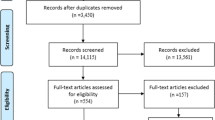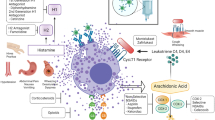Abstract
Purpose
Review the literature to update the MASCC guidelines from 2016 for controlling nausea and vomiting with systemic cancer treatment of low and minimal emetic potential.
Methods
A working group performed a systematic literature review using Medline, Embase, and Scopus databases between June 2015 and January 2023 of the management of antiemetic prophylaxis for anticancer therapy of low or minimal emetic potential. A consensus committee reviewed recommendations and required a consensus of 67% or greater and a change in outcome of at least 10%.
Results
Of 293 papers identified, 15 had information about managing systemic cancer treatment regimens of low or minimal emetic potential and/or compliance with previous management recommendations. No new evidence was reported that would change the current MASCC recommendations. No antiemetic prophylaxis is recommended for minimal emetic potential therapy, and single agents recommended for low emetic potential chemotherapy for acute emesis, but no prophylaxis is recommended for delayed emesis. Commonly, rescue medication includes antiemetics prescribed for the next higher level of emesis.
Conclusion
There is insufficient data to change the current guidelines. Future studies should seek to more accurately determine the risk of emesis with LEC beyond the emetogenicity of the chemotherapy to include patient-related risk assessment.

Similar content being viewed by others
Data Availability
All data supporting the findings of this study are available within the paper and its publicly available references.
References
Hesketh PJ, Kris KG, Grunberg SM et al (1977) Proposal for classifying the acute emetogenicity of cancer chemotherapy. J Clin Oncol 15:103–109
Hesketh PJ (1999) Defining the emetogenicity of cancer chemotherapy regimens: relevance to Clinical practice. Oncologist 4(3):191–196
Hesketh PJ, Kris MG, Basch E et al (2020) Antiemetics: ASCO guideline update. J Clin Oncol 38:2782–2797
Jordan K, Chan A, Gralla R, Jahn F, Rapoport B, Ruhlmann CH, Sayegh P, Hesketh PJ (2023) Emetic risk classification and evaluation of the emetogenicity of antineoplastic agents – Updated MASCC/ESMO consensus recommendation. Support Care Cancer (in press)
Razvi Y, Chan S, McFarlane T et al (2019) ASCO, NCCN, MASCC/ESMO: a comparison of antiemetic guidelines for the treatment of chemotherapy-induced nausea and vomiting. Support Care Cancer 27:87–95
Olver I, Ruhlman C, Jahn F et al (2017) 2016 Updated MASCC/ESMO consensus recommendations: Controlling nausea and vomiting with chemotherapy of low or minimal emetic potential. Support Care Cancer 25:297–301
Page MJ, McKenzie JE, Bossuyt PM et al (2021) The PRISMA 2020 statement: an updated guidelines for reporting systematic reviews. BMJ 372:n71. https://doi.org/10.1136/bmj.n71:10.1136/bmj.n71
Encinosa W, Davidoff AJ (2017) Changes in antiemetic overuse in response to choosing wisely recommendations. JAMA Oncol 3:320–326
Okuyama A, Nakamura F, Higashi T (2017) Prescription of prophylactic antiemetic drugs for patients receiving chemotherapy with minimal and low emetic risk. JAMA Oncol 3:344–350
Caracuel F, Muñoz N, Baños U, Ramirez G (2015) Adherence to antiemetic guidelines and control of chemotherapy-induced nausea and vomiting (CINV) in a large hospital. J Oncol Pharm Practice 21:163–169
Ebrahimi M, Mehrzad V, Moghaddas A (2020) Adherence to ASCO for prophylaxis of acute chemotherapy-induced nausea and vomiting. Asian Pac J Cancer Prev 21:1567–1572
Nikbakht Z, Rajabi M, Shahrasbi A, Roohi E, Hashemian F (2021) Evaluation of adherence to antiemetic treatment guidelines in patients with chemotherapy-induced nausea and vomiting in teaching hospitals in Iran. J Canc Edu 36:1022–1029
Bun S, Kunisawa S, Sasaki N et al (2019) Analysis of concordance with antiemetic guidelines in pediatric, adolescent, and young adult patients with cancer using a large-scale administrative database. Cancer Med 8(14):6243–6249
Kandasamy G, Sivanandy P, Khobrani M et al (2019) Effectiveness of antiemetics in the management of chemotherapy-induced nausea and vomiting in cancer patients following chemotherapy guidelines. Indian J Pharm Sci 81:757–765
Jordan K, Gralla R, Jahn F, Molassiotis A (2014) International antiemetic guidelines on chemotherapy induced nausea and vomiting (CINV): content and implementation in daily routine practice. Eur J Pharmacol 722:197–202
Araz M, Karaagac M, Korkmaz L et al (2019) The compliance with antiemetic guidelines of Turkish medical oncologists. A survey study of Turkish Oncology Group. Curr Probl cancer 43:344–353
Roila F (2004) Transferring scientific evidence to oncological practice: a trial of three different implementation strategies on antiemetic prescriptions. Support Care Cancer 12:446–453
Grunberg SM (2009) Obstacles to the Implementation of Antiemetic Guidelines. J Natl Compr Canc Netw 7:601–605
Affronti ML, Schneider SM, Herndon JE et al (2014) Adherence to antiemetic guidelines in patients with malignant glioma: a quality improvement project to translate evidence in to practice. Support Care Cancer 22:1897–1905
Ohata K, Fujii H, Sadaka S et al (2021) Comparison of chemotherapy-induced nausea and vomiting between gemcitabine plus nab-paclitaxel combination chemotherapy and gemcitabine monotherapy in patients with advanced pancreatic cancer. Anticaner Res 41:3643–3648
De las Peñas R, Blasco A, De Castro J et al (2016) SEOM clinical guideline update for the prevention of chemotherapy-induced nausea and vomiting (2016). Clin Transl Oncol 18:1237–1242
Okada Y, Oba K, Furukawa N et al (2019) One-day versus three-day dexamethasone in combination with palonosetron for the prevention of chemotherapy-induced nausea and vomiting: a systematic review and individual patient data-based meta-analysis. Oncologist 24:1593–1600
Hesketh PJ, Morrow G, Aw K et al (2021) Efficacy and safety of palonosetron as salvage treatment in the prevention of chemotherapy-induced nausea and vomiting in patients receiving low emetogenic chemotherapy (LEC). Support Care Cancer 20:2633–2637
Vig S, Siebert L, Green MR (2014) Olanzapine is effective for refractory chemotherapy-induced nausea and vomiting irrespective of chemotherapy emetogenicity. J Cancer Res Clin Oncol 140:77–82
Dranitsaris G, Joy A, Young SD, Clemons M, Callaghan W, Petrella T (2009) Identifying patients at high risk of nausea and vomiting after chemotherapy. The development of a practical predicting tool I. Acute nausea and vomiting. J Support Oncol 7
Petrella T, Clemons M, Joy A, Young S, Callaghan W, Dranitsaris G (2009) Identifying patients at high risk for nausea and vomiting after chemotherapy: the development of a practical validated prediction tool II. Delayed nausea and vomiting. J Support Oncol 7
Hayashi T, Shimokawa M, Miyoshi T et al (2017) A prospective, observational, multicentre study on risk factors and prophylaxis for low emetic risk chemotherapy-induced nausea and vomiting. Support Care Cancer 25:2707–2714
Smit T, Kotze I, du Plessis J (2021) The incidence of nausea in the absence of vomiting in patients receiving intravenous chemotherapy. Ann Palliat Med 10:2679–2686
Author information
Authors and Affiliations
Contributions
The initial draft was written by IO and all authors revised it critically for its intellectual content.
All authors reached agreement on the recommendations, are accountable for the accuracy and integrity of the work, and have approved the version to be published.
Corresponding author
Ethics declarations
Conflict of interest
Schwartzberg COI: Consultant, Helsinn, GlaxoSmithKline, Pfizer.
The other authors have no relevant financial or non-financial interests to declare.
Additional information
Publisher's Note
Springer Nature remains neutral with regard to jurisdictional claims in published maps and institutional affiliations.
Rights and permissions
Springer Nature or its licensor (e.g. a society or other partner) holds exclusive rights to this article under a publishing agreement with the author(s) or other rightsholder(s); author self-archiving of the accepted manuscript version of this article is solely governed by the terms of such publishing agreement and applicable law.
About this article
Cite this article
Olver, I., Clark-Snow, R., Ruhlmann, C.H. et al. 2023 updated MASCC/ESMO consensus recommendations: controlling nausea and vomiting with chemotherapy of low or minimal emetic potential. Support Care Cancer 32, 37 (2024). https://doi.org/10.1007/s00520-023-08223-2
Accepted:
Published:
DOI: https://doi.org/10.1007/s00520-023-08223-2




